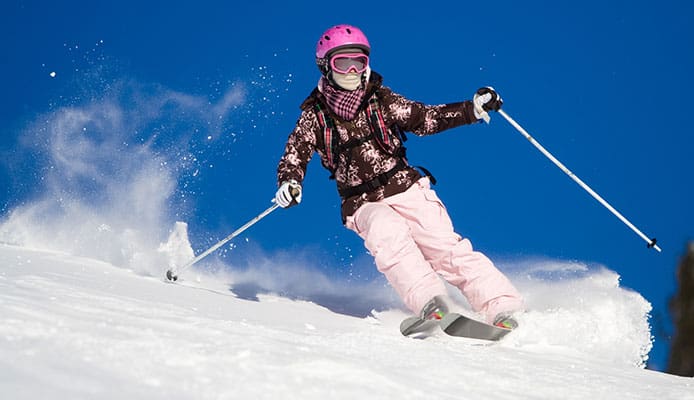
Thanks to their ability to tackle multiple terrain conditions, all around skis are the perfect option for those of you who equally enjoy carving the piste and riding powder. With the same set of all around skis, you can easily handle hard-packed snow at the peaks and soft snow in the trees.
But how do you find a great pair of skis? Various aspects like length, profile, sidecut, and flex all influence how your all terrain skis are going to perform on the snow. Top rated all-around skis are just as important as your other ski gear, so you should take the time to canvas different products and reviews before making a decision.
To help you in your search, we’ve have listed the ten best all-around skis of 2023 for all experience levels – from beginners to experts. These skis are the top of their class and come packed with all the newest features. And, if you want to learn more about what makes a great ski, don’t forget to check the buying guide below.
OUR TOP PICK
Nordica Enforcer 104 Free
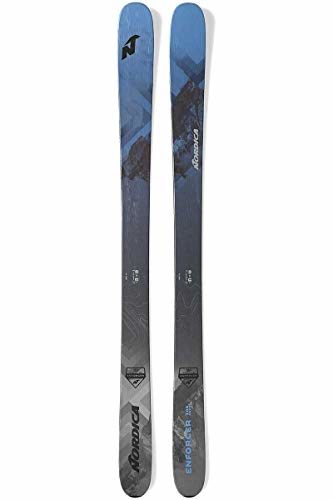
- Stand Out Features - Why We Love It
- Blunt Nose Profile prevents tip bouncing
- ABS sidewalls for improved rigidity and durability
- Two sheets of metal in the core maximize stability
- Compatible with a large number of bindings
- Extra-fast and great for experienced riders
Length: 172/179/186cm
Width (Tip/Waist/Tail): 135/104/124mm (@186cm)
Profile: Rocker/Camber/Rocker
Turn radius: 18.5m (@186cm)
Core: Wood, Metal laminate
Weight: 10.6 pounds (pair)
Skill Level: Expert/Pro
Bindings: No
Year: 2020
EDITORS CHOICE
Salomon QST 99
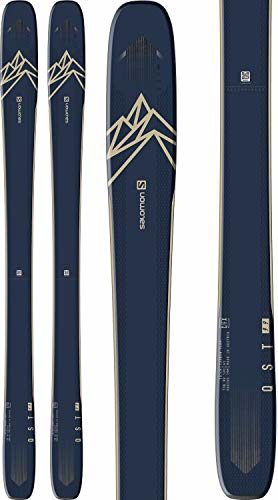
- Stand Out Features - Why We Love It
- Carbon-powered C/FX layer makes the skis more powerful
- Cork Damplifier technology in the tip for increased stability
- Shape makes switching edge to edge easier
- Full Sandwich sidewalls improve the ski’s precision and grip
- Absorbs shocks and vibrations for a smoother ride
Length: 167/174/181/188cm
Width (Tip/Waist/Tail): 134/99/116mm (@174cm)
Profile: Rocker/Camber/Rocker
Turn radius: 19m
Core: Poplar wood
Skill Level: Intermediate/Advanced
Bindings: No
Year: 2019
BEST VALUE
Volkl M5 Mantra
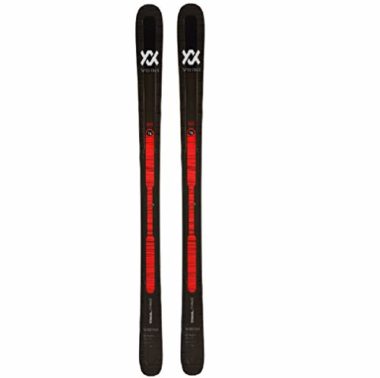
- Stand Out Features - Why We Love It
- Titanal frame with metal in the tip and tail areas
- Carbon fiber inlay at the tip improves precision
- New shape and tightened radius for better edge to cut turns
- End rocker improve floating in deeper snow
- Camber underfoot and sidewall construction for the best performance
Length: 170/177/184/191cm
Width (Tip/Waist/Tail): 134/96/117mm (@177cm)
Profile: Rocker/Camber/Rocker
Turn radius: 19.8m (@177cm)
Core: Woodcore with Titanal laminate
Weight: 4.475lbs (per ski, @177cm)
Skill Level: Advanced/Expert
Bindings: No
Year: 2020
Rossignol Pursuit 100 All-Around
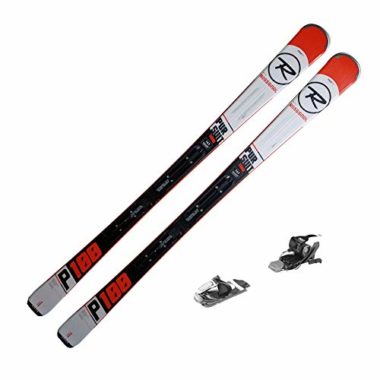
- Stand Out Features - Why We Love It
- Specific beginner-friendly design makes progress easy
- Almost full camber underfoot gives excellent edge grip
- Rockered tip allows the ski to float
- Wide tip with small taper for easier turning
- Xpress 10 bindings come with the skis
Length: 135/142/149/156/163cm
Width (Tip/Waist/Tail): 126/74/111mm (@163cm)
Profile: Rocker 10% (tip), Camber 90%
Turn radius: 13m (@163cm)
Core: Wood
Weight: 6.39lbs (pair, @163cm)
Skill Level: Beginner/Intermediate
Bindings: Yes, Xpress 10 bindings
Year: 2019
Rossignol Pursuit 200
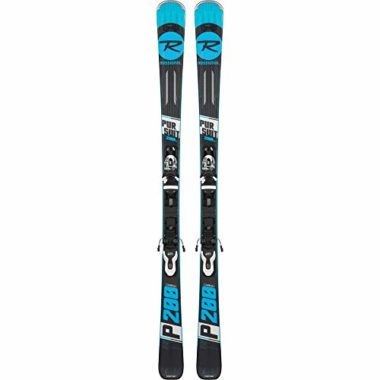
- Stand Out Features - Why We Love It
- Large camber underfoot for top-level edge grip
- Poplar wood core reduces ski swing weight
- Sidecut allows making very tight turns
- Great for intermediate riders looking to improve
- Xpress 10 bindings come with the skis
Length: 149/156/163/170cm
Width (Tip/Waist/Tail): 126/74/111mm (@163cm)
Profile: Rocker 10% (tip), Camber 90%
Turn radius: 13m (@163cm)
Core: Poplar wood
Weight: 6.39lbs (pair, @163cm)
Skill Level: Intermediate/Advanced
Bindings: Yes, Xpress 10 bindings
Year: 2019
Armada ARV 84
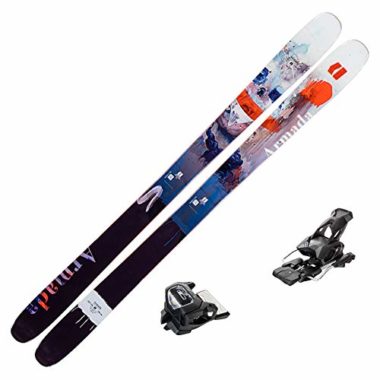
- Stand Out Features - Why We Love It
- Laminate fiberglass matrix improves stability
- Medium flex makes them incredibly versatile
- Poppy and playful even for the park
- Excellent size for older children
- Lithium GW Bindings included with the skis
Length: 142/156/163cm
Width (Tip/Waist/Tail): 112/84/105mm (@163cm)
Profile: Camber
Turn: 16.5m (@163cm)
Core: Poplar wood
Weight: 2.72lbs (per ski, @163cm)
Skill Level: Intermediate/Advanced
Bindings: Yes, Lithium GW bindings
Year: 2020
Head Kore 93 Men’s
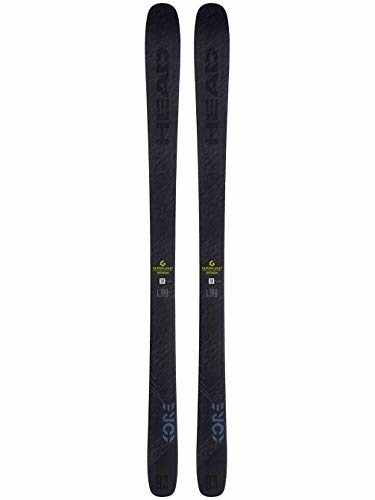
- Stand Out Features - Why We Love It
- Tip to tail rocker for an early rise and better float
- Carbon sandwich cap construction
- Karuba wood core gives a great pop
- Underfoot camber helps cut turns better
- Reliable grip for carving hard-packed snow
Length: 162/171/180/189cm
Width (Tip/Waist/Tail): 133/93/115cm (@180cm)
Profile: Rocker/Camber/Rocker
Turn: 16.4m (@180cm)
Core: Carbon, Graphene, Koroyd, Wood
Skill Level: Intermediate/Advanced
Bindings: No
Year: 2019
Nordica Enforcer 100 Men’s
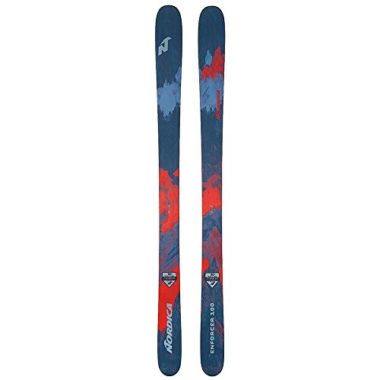
- Stand Out Features - Why We Love It
- Float tip and tail rocker for easier turning in powder
- Titanium and wood construction improve ski power
- ABS sidewalls give top-level edge grip and precision
- Ideal for unpredictable conditions and high speeds
- Full freedom of movement on a wide stable base
Length: 177, 185cm
Width (Tip/Waist/Tail): 133/100/121 (@185cm)
Profile: Rocker/Camber/Rocker
Turn: 18.5m (@185cm)
Core: Wood, Carbon
Weight: 9.4lbs (package)
Skill Level: Advanced/Expert
Bindings: No
Year: 2019
Volkl Kendo

- Stand Out Features - Why We Love It
- Refined shape is ideal for on and off-piste skiers
- Perfect width for both fresh and packed snow
- Tip rocker with moderate taper engages turn easily
- Rockered tail lets skier release or hold the turn
- Wood core and metal laminate increase durability
Length: 163/170/177/184cm
Width (Tip/Waist/Tail): 127/90/110 (@177cm)
Profile: Rocker/Camber/Rocker
Turn: 20.8m (@177cm)
Core: Wood with metal laminate
Weight: 4.27lbs (@177cm)
Skill Level: Advanced/Expert
Bindings: No
Year: 2019
Blizzard Bonafide
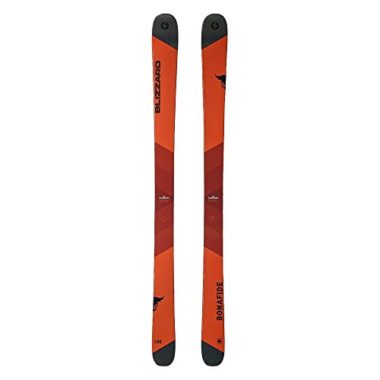
- Stand Out Features - Why We Love It
- Rocker camber profile balances an edge hold with float and mobility
- Carbon Flipcore design provides a smoother ride
- Poplar beech wood core for reduced overall weight
- Carbon + Ti binding interface gives better energy transfer
- Performs great at higher speed
Length: 166/173/180/187cm
Width (Tip/Waist/Tail): 135/98/119 (@173cm)
Profile: Rocker/Camber/Rocker
Turn: 16.5m (@173cm)
Core: Poplar, Beech, Titanal
Weight: 5lbs (@173cm)
Skill Level: Advanced/Expert
Bindings: No
Year: 2019
How To Choose The All Around Ski – Buying Guide
Length (Size)
The length of your skis greatly influences how fast they are and how easy they are to control. Most brands measure the length in centimeters and provide the info in the sizing chart. To get the most efficient all mountain skis, you should always use each brand’s provided chart because even slight differences between brands can mean you may need to size up or down.
You choose the length based on your own height. The length should be similar to your height, so the tip is somewhere between your chin and head top when you plant the tail in the snow. Of course, you can adjust this based on your skill level and type of skiing.
Shorter skis generally perform better on groomed trails, as they have a much smaller turning radius making it easier to carve the snow. They are more stable at lower speeds, making them a good choice for learning. Also, you should get a shorter ski if you weigh less than average for your height, so it supports you properly. The downside is that they are slower.
Longer skis float better and go much faster downhill. You can ride them off-track and they won’t sink into the powder easily. However, this length also means a significantly larger turning radius, so you won’t be able to make quick turns with extra-long skis. In addition to speed, you should get longer skis (relative to your height) if you weigh more than average for your height.
If you get skis that are too small, they may struggle to correctly support your weight. The proper length (and support) will deliver optimal performance, which is why the skier’s height and weight should always be considered. If you are above average or under average in height or weight, adjust the length of your skis accordingly.
Width
The width of your all-terrain skis will affect the stability, flex, and ease of turning. It will likely be measured in millimeters and may be referred to as underfoot. Modern all-terrain skis are wider than models in the past, making them more stable.
Generally speaking, narrow skis (80-90mm) are best for groomed trails and carving the piste. Medium-width skis (90-100mm) can be used on both groomed trails and powder runs, as they are the most versatile. Finally, anything 100mm and above is considered a wide ski and works best in heavy powder conditions because they float well.
Additionally, it’s also important to consider the skier’s size when picking width. This is why men’s models are typically wider compared to women’s models. A wider ski gives much better support to a larger body frame.
On the other hand, going too wide will decrease the ski’s ability to easily go from edge to edge and turn. So, it’s best to try and find a balance when choosing width and adapt it to your style of skiing.
Weight
As you can imagine, the weight of your skis also has a big influence on their overall performance. Both lighter and heavier skis have their advantages and disadvantages, and deciding which is better is going to depend on your experience and preferred skiing style.
If you want to have full control, turn quickly, and ski powder, a lightweight ski is going to be essential for you. These skis are more playful and allow you to be faster when moving through the trees. As a bonus, they don’t create a lot of pressure on your legs when turning, meaning they are better for your joints.
On the other hand, a heavy ski stays on the snow better, creating a much stronger grip. Because of this, they also have significantly less bounce and vibration when going through bumps and crud. Unfortunately, they are much harder to turn and might leave you exhausted halfway down the mountain (especially if you’re a beginner skier).
Since all-terrain skis are meant to be universal (for both packed and powdered snow), they should lean towards a lighter design. A ski that saves on weight will ensure that you can float on top of the snow and make quick turns, rather than get stuck in it. If you need more help with this, check out our guide about ski weight.
Stability and Speed
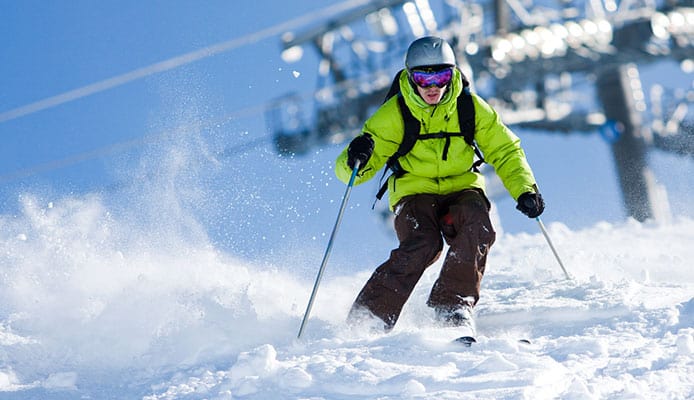
High stability allows you to move at a higher speed without struggling to maintain control. This is particularly important for beginner skiers who have yet to master proper skiing techniques. Typically, the faster you go, the less control you have. On top of this, the ski should remain stable when making turns too (otherwise you’re in for a rough ride).
But what determines whether a pair of skis has decent stability? You should look for 3 key features: flex, sidecut, and camber profile. Longer sidecuts, stiffer flex, and underfoot camber profiles will result in increased stability, and you can find this combination on most top rated all-around skis. Due to its unique design, an all-mountain carving ski will remain very stable even at a higher speed.
Most all-terrain skis work best for intermediate to expert riders, especially for those who are looking for a fast-paced adrenaline rush. But beginners shouldn’t be afraid to try a pair of all-terrain skis either. While some models are initially more difficult to learn to control, the increased stability can help you stay on your feet (less time falling) and make progress faster.
Stiffness (Flex)
Stiffness can be one of the most challenging features to balance in skis. Both soft and firm skis have their pros and cons, depending on what you like to do on the mountain and how experienced you are.
A soft ski is great for absorbing bumps and dampening vibrations. This gives you a significantly smoother and more stable ride with easier turns. A softer ski is very forgiving, and making a beginner mistake won’t immediately result in a fall. However, they are much slower downhill and tend to limit your progress.
On the other hand, choosing stiff (firm) all-mountain carving skis allow you to reach much higher speeds while going downhill, but at the cost of highly reduced stability. Stiff skis are also more difficult to turn and require more leg power. For this reason, most models have a medium flex that guarantees a good performance in various conditions.
Ultimately, the stiffness of the ski is determined by the materials used to make it. A stiff ski will likely use a double layer of metal, such as Titanal, to increase the stiffness. The metal should run the full length and width of the ski. While this does add a little more weight, it also makes the skis more durable for skiing all the varying terrain.
Sidecut
The sidecut of the ski refers to the hourglass shape of the ski’s body. A ski is wider at the tip and tail and narrower at the waist. This makes it curved inward, which we call a sidecut. But why do skis have this? Well, a sidecut allows the ski to turn in a curve, which would be nearly impossible with a flat side.
The amount of sidecut, in combination with ski length, determines the turning radius of a pair of skis. For example, a shorter ski with a bigger sidecut will make much tighter turns than a long ski with less sidecut. When talking about all-around skis, the turning radius is usually somewhere between 11 and 20 meters.
In practical terms, if you’re an inexperienced skier, you should go with a shorter ski with more sidecut. This will allow you to make sharper turns and give you better control at a lower speed. On the other hand, if you’re an advanced skier, a longer ski with less sidecut allows you to make much wider turns so you can maintain speed.
Profile
Another very important factor when choosing a ski is its profile. You see a ski’s profile when you lay it flat on the ground without any load on it, and look at it from the sides. A ski profile can be a camber, a rocker, or numerous combinations of the two (all with their own advantages). For the most versatile performance, all-around skis usually have a camber underfoot with rocker tip and tail.
Camber: When flat on the ground, a cambered ski will have the middle section lifted off the ground. However, when you put on your boot and step on the ski, this lifted surface comes in full contact with the snow and creates a very large surface area. Also, when turning, the edge has much longer contact with the snow.
As you lift out of the turn, you should feel a pop, which is what helps propel you into your next turn. The chamber design is so popular because it provides the best contact with the snow while ensuring excellent edge control for carving groomed slopes.
Rocker (Reverse Camber): The rocker design has the tip and tail of the skis raised, which makes the ski shape resemble a banana (or a rocking chair). The lifted ends prevent the ski from diving into the snow, making it excellent for deep snow conditions and powder.
The downside to a rocker is that the flat surface of the underfoot can make the ski less stable in turns and doesn’t hold an edge like a traditional camber. To combat these problems, a mixed camber and rocker have proven extremely popular.
Mixed Camber and Rocker: With both camber and a rocker in one design, skiers can enjoy the benefits of both. A mixed camber and rocker are highly popular because it’s suitable for any skiing ability and works great both on and off-piste. The combination gives you better edge control (like a traditional camber) but also floats in crud and powder (like a rocker).
Mixed camber and rocker design will vary by brand. Some brands use the rocker only in the tip, while others have a rocker in both the tip and the tail. This is the type of ski we would recommend for all-mountain riders, as it’s best equipped to conquer the challenges on and off-trail. If you want to learn more, be sure to read our article on camber vs rocker.
Materials (Construction)
Most modern all-terrain skis use two materials to form the ski – a wood core and metal laminates. Materials used determines not just a ski’s weight, but also the flex, stability, and durability. To keep the weight low, the core is usually made of some high-quality wood (poplar for example). Different hardwoods may be used, all of which are sturdy enough to hit the slopes.
However, wood alone won’t have you carving the mountain. Alongside wood, two layers of metal give you the edge you need to cut turns. The most common type of metal used is Titanal (an alloy made of 85% aluminum and small amounts of zinc, magnesium, and copper).
This metal is a great choice because it offers high-speed stability, muscle, and dampness. Playful skis will use less Titanal because they want to keep their flex and spring. Titanal also bonds well with other materials, hence the combination with wood. And the best thing is that Titanal will retain its strength even if torqued in a variety of directions, which is why we highly recommend a Poplar/Titanal combo.
You might also like: Top Ski Pants
Performance In Different Conditions
Even though all-terrain skis are the jack of all trades, there are still many differences between the models and how they perform in various situations. Take a look at how to get the most from your skis in each scenario.
Carving: This refers to a turning technique where you use the curvature of the skis to turn. You shift the ski to the side, it bends in an arch, and then the sidecut of the ski allows it to make a curve. Carve skiing means that you are using the full length of your edge to cut into the snow without sliding.
If you’re enjoy carving and making tight turns, look for all-terrain skis that are shorter in length, have a camber underfoot, and a larger sidecut.
Additionally, carving on packed snow will be more complicated than on powder snow. Because packed snow is more like ice, it’s hard for the edges of your ski to cut into it which creates a problem of gaining the control you need to turn. To improve carving on icy terrain, choose skis that strong edges and sidewalls, and learn how to tune skis.
Powder Performance: If you’ve ever seen an expert skier cut through powdered snow, you may be wondering how they make it look so effortless. While it takes skill to maneuver through powder, part of the equation also has to do with having skis that deliver an enhanced powder performance. But what is powder performance?
Powder performance refers to how well a pair of skis can float through the powder. Instead of sinking deeply into the snow, floating is an important feature for all-terrain skis so that the skier can have fluid motion. If you want your ski to perform well in powder, look for a model that has an accented rocker on the tip and tail.
While a full rocker ski is best for deep powder, you still need camber for stability and support. For most all-terrain skis, the underfoot will be camber, while the tip and tail have a rocker profile to keep them gliding over the snow.
Crud Performance: While every skier dreams of nicely groomed trails or fine powdered snow, you don’t always get to ski the best terrain. One of the less desirable snow conditions (but one that riders often encounter), is crud. Crud is any type of snow that is choppy, slushy, icy, or generally unpleasant to ski.
The most efficient skis will be able to tackle crud head-on, without struggling to turn, carve, or stop. How a ski handles crud is determined by the waist width and whether or not it has a rocker profile.
As we’ve mentioned, the rocker profile of your ski keeps the tips and tail above the snow. Besides allowing you to float, this also keeps you above choppy snow. As for the width, a wider ski has a larger surface area to keep you above the crud.
Together, the tip and tail rocker and increased width will help enhance the crud performance and keep you steady on your feet. Stability is an important part of crud performance because you are more likely to encounter uneven movements and shifts.
Bump Performance: Most skiers will immediately associate bumps with moguls, which are a type of bump that you may encounter on the mountain. Instead of groomed bumps (like moguls), we’re referencing the bumps that can appear because a trail is oversized.
Bumps on the trails develop because too many riders have passed through. Unlike moguls, these are less groomed and are more erratic in their size, shape, and spacing. For the best bump performance, all-terrain skis should be flexible, stable, and responsive.
A softer ski (more flexible) will do a much better job at dampening the hits and vibrations you have while riding over bumps. This also makes the skis more stable and reduces the chance to fall. Also, it helps if your ski is responsive and has a solid underfoot, allowing a quicker reaction on uneven terrain.
Playfulness: One aspect that skiers may not initially consider but end up enjoying it is the playfulness of their skis. Playful all-terrain skis should be easy to use, have a fast response, and adapt to the changing terrain. In other words, it should simply be fun to use.
But what makes a ski playful? For most skis, the playfulness will rely on the flex and weight of the ski. All-terrain skis that are more flexible will have a looser movement, which can better shift from flat surfaces to gullies and air jumps. The flex will soften landings and make it easier for riders to jump, flip, and turn.
Additionally, lightweight skis will have a better lift and won’t hold the skier down. For the adrenaline-seeking skiers, this means that they can launch off of installed park pieces and catch some air. All-terrain models are a little looser in their turns and jumps, allowing you to enjoy the speed, jumps, flips, and turns you may encounter on your run.
All-Mountain Front vs. All-Mountain Back
Depending on where you spend more time, all mountain skis can be split into two categories – frontside and backside. While every all-terrain ski performs relatively well in every surrounding, these small tweaks in design might help it perform better on your favorite runs.
All-mountain front skis are models that are enhanced for on-piste riders. They are great for groomed trails and runs, where you don’t encounter heavy powder. With a narrow waist and less flex, they have increased stability and edge hold for carving turns.
For heavy powder and off-piste runs, all-mountain back skis are the better choice. These skis are often broader and more flexible than all-mountain front skis, which helps them effortlessly glide through heavy powder. They won’t be as good at carving maybe even won’t be as fast, but they are the more suitable option for off-trail mountain riders.
Women’s All Mountain Skis
If you’re a woman, there’s a large chance that a standard unisex or men’s model won’t be ideal for you. Because a female body has a different stance and weight distribution, most modern brands now have women-specific designs. We’re not just talking about cosmetic differences like colors, but also about a softer flex and a shorter length.
Newer women’s all-terrain skis have repositioned mounting points and weigh less so a woman can balance the ski easier. On top of this, a soft flex is more comfortable to control and better accommodate hard carving turns.
Of course, if you’re used to unisex skis, it’s not required that you use a women-specific model. Ultimately, you should get the skis that feel best. If you’re interested in this topic and want to learn more, check out our article about women’s all terrain skis.
FAQs
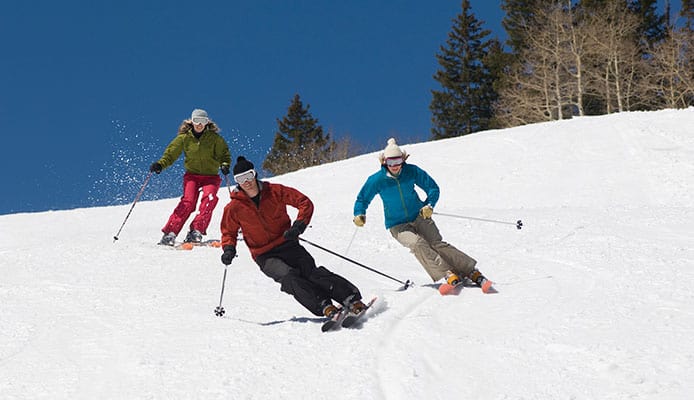
Q: What is an all-mountain ski?
An all-mountain ski is a ski specifically designed to tackle groomed snow and off-piste powder equally well. Skiers should be able to use these skis on any slope they encounter, which makes this type of ski a popular investment. Besides terrain versatility, they are also an excellent choice for riders of different skill levels (beginners to experts).
In general, most all-terrain skis will have a width of 85-105mm, which makes them ideal as both all-mountain front and all-mountain back skis. Narrower skis cater towards groomed skiers, who prefer to stick to maintained trails. Wider skis are better for the off-trail riders who like to hit powder and maneuver through the trees.
While all-terrain skis are targeted as the ski everything design, they aren’t ideal for the backcountry. The best backcountry skis are specifically designed for deep powder and off-trail locations. They are also heavier than other ski designs, especially with the ski bindings added, which makes them harder to use for uphill travel.
Finally, there are still differences in ski designs, which is why we made this guide to help you choose the best pair. For the best performance, you should consider the local ski conditions, your skiing style, and your ability level. With these considerations, we are confident that you can find an all-terrain ski that performs to high standards.
Q: What are all-mountain wide skis?
All-mountain wide skis have a wider body or waist, which makes them more stable, slightly less flexible, and less responsive. While these may seem like negative traits, they are perfect for off-trail and powder ski days.
The width of the ski will affect how stable a skier is when they’re making turns, and it will determine the speed of the skis. All-mountain wide skis will be slower because a larger surface area is in contact with the snow. For powder, this means that the ski can float above the snow and cut through turns more easily.
If you’re a beginner skier, wide skis might be the better choice because they are an excellent base for learning. Slower speed, better stability, and slightly slower response give beginner riders more time to make a turn. If you’re an expert skier, you might want to go with a narrower ski that goes faster.
Q: What is the difference between freeride and all terrain skis?
Freeride skis are usually wider and have a larger turn radius than all-terrain skis. This means that they may struggle in hard snow conditions and won’t carve as easily. Freeride skis are made for off-trail skiing and may not have a tremendous on-piste performance like an all-mountain ski.
All-terrain skis have a narrower waist and a shorter turn radius than freeride skis. They will excel at skiing hard snow conditions and carving groomed snow. In addition, they work well both on and off the piste, making them the best choice for riders who like to try different types of skiing.
Q: How long do skis last?
Statistics say that an average skier is going to replace their skis every 8 years. However, giving a more straightforward answer isn’t easy because this depends on various factors – ski quality, skiing style, your bodyweight, and how well you maintain the ski.
All-terrain skis that are properly cared for can last for 200-300 days on the slopes. If your skiing season lasts very long, this translates to just a couple of years. Luckily, it’s much longer for most of us. Also, if you’re an aggressive skier or weigh more, the skis are going to be under more strain and wear out faster.
Q: Are all around skis good for powder?
Yes, they are. Most all-terrain skis have a wider underfoot and a rocker profile at the tip and tail, allowing them to float well on powder snow. They don’t sink easily so you can glide even on deep ungroomed snow. While they won’t be as responsive in powder as true powder skis, they will still do a great job.
Globo Surf Overview
For skiers who like to conquer the peaks, trees, and trails alike, an all-mountain ski is the perfect choice. The best all around skis can be taken on groomed runs as well as on off-trail locations. If you’re a skier who likes a little taste of everything, all-terrain skis are all you need.
Having the right gear is important, or else your day on the slopes might turn into a disappointment. With the help of our guide, you’ll be able to find great-fitting skis you’ll enjoy for a long time. From the fresh powder to the less indulging crud, your new skis can take you anywhere, so there’s no excuse not to have some fun on the slopes!

